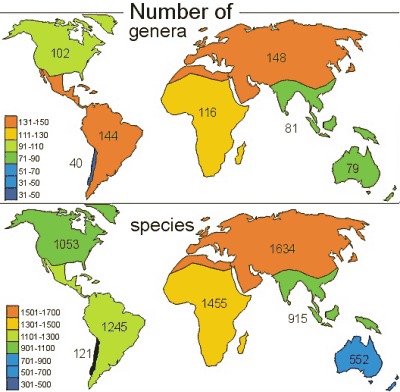

HULL (1962): "The Asilidae are world wide in distribution. The majority of these species and genera are found north of the southern tropic, the reduced land masses below this latitude producing fewer. Certain groups significantly characterize certain regions. No endemic or introduced species are known from the Hawaiian Islands but Laphriini and some other types occur sparsely on the smaller islands groups. All larger islands south of Asia have a rather abundant asilid fauna, and a few extend onto Fiji, Samoa, New Zealand, and one species is found on Christmas Islands.
It is possible to point to genera which constitute characterictic features of certain regions. In the Neotropical region the Megapodinae are unique. In the same region we find a concentration of the Atomosiini and the Holcocephala Jaennicke branch of the Damalini, as well as the prominent, southward extension of Diogmites Loew of the Dasypogoninae and of Nerax, new genus, from the Asilinae. Probably Mexico and northern South America can be regarded as the home of the last two named genera; however, the United States is very rich in representatives of both.
In the northern hemisphere the genera Laphria Meigen, Cyrtopogon Loew, Lasiopogon Loew, and the genus Asilus Linné, sewnsu lato, predominate. The Neolophonotus Engel group of the Asilinae and the genus Microstylum Macquart of the Dasypogoninae are epecially well represented in South Africa. In southern Asia and the larger South Pacific islands, the beautiful, metallic flies of the genus Maira Schiner replace Laphria Meigen. Oddly, the Laphriinae have produced the metallic species in the genus Lampria Macquart in the New World tropics, which seem to parallel Maira Schiner.
The majority of species of Asilidae frequent dry and sandy areas, a condition well shown by the greater numbers of species found in arid and semiarid regions; but even in desert or semidesert country the small drains of dry steam beds attract the greatest number, and sometimes the entire robber fly population of a region will be restricted to such places, which also have the maximum vegetation and the greatest population of insects upon which the flies feed. In such country one may often look in vain for Asilidae beyond the banks of stream bed. In temperate regions a few species occur in wet swamp areas and deep forests. As Bromley (1946) has pointed out, the number of species which occur deep within woods in limited, and these flies tend definitely to concentrate on the edges of woodlands, where shrubs occur and give way to grassland. I spent several weeks at the Canal Zone Biological Area of the Smithsonian Institution, on Barro Colorado Island in Gatun Lake. There in the rain forest never was an Asilid seen within the forest, but several species occurred among the high grass along the edge of clearings. There are species which prefer grasslands, and the plains also have their representatives. Next to semidesert areas, pobably savannah country attracts the greatest number. It is said that about 500 or more species occur in California; this may be attributed to the very diverse habitats and climates, of the State and to its length."
WOOD (1981): "Asilids of all four subfamilies are found in all continents except Antarctica, and they are particularly abundant in the warm temperate and tropical areas of the world. The Neotropical region and the Australian region both have an especially rich and interesting fauna, whereas New Zealand has very few species..."
LEHR (1988): "About 5500 species of Asilidae are known in the world. Most of them inhabit warm countries. They are particularly numerous in savanna, steppe and desert regions. Considerably fewer robber flies are to be found in forests where they occur in glades and on river banks. Rare species occurring in damp swampy sites. Along river systems Lasiopogon penetrates into the tundra zone whereas Cyrtopogon is observable in the mountains at heights of 4500 m above sea level."
 | |
(after Geller-Grimm, 2000 - unpubl.) |
|